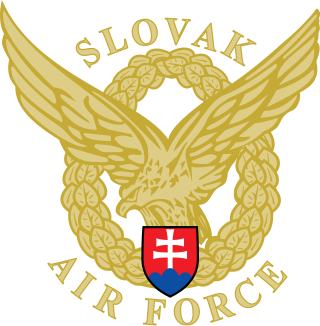Top Qs
Timeline
Chat
Perspective
Slovak Air Force
Air warfare branch of Slovakia's military From Wikipedia, the free encyclopedia
Remove ads
The Slovak Air Force, known since 2002 as the Air Force of the Armed Forces of the Slovak Republic (Slovak: Vzdušné sily Ozbrojených síl Slovenskej republiky), is the aviation and air defense branch of the Slovak Armed Forces. Operating 15 aircraft and 18 helicopters from three air bases : Malacky–Kuchyňa, Sliač, Prešov. It succeeded the Czechoslovak Air Force together with the Czech Air Force in 1993. The Slovak Air Force is part of NATO Integrated Air Defense System – NATINADS.[2][3][4][5][6]
The Slovak Air Force is tasked with the defense of the sovereign Slovak state and the support of the nation's ground troops.[7] Following the retirement of the Mikoyan MiG-29 in 2022, 7 L-39 Albatros provide the fast-jet capability role to the air force, awaiting the delivery of American F-16 Fighting Falcon aircraft in 2024. 6 Let-410 Turbolet aircraft provide surveillance and transport capabilities, while 2 C-27 Spartan transports provide a light tactical airlift capability. The helicopter fleet consists of 9 Mil Mi-17, gradually being replaced by the UH-60 Black Hawk.
The Slovak Air Force has been under the command of Major General Róbert Tóth since January 1, 2021.[8][9][10][11][12][13]
Remove ads
History
Summarize
Perspective
1914–1918
Many Slovak pilots served in Austro-Hungarian Aviation Troops or in Entente air forces. Some Slovak pilots as part of Czechoslovak Legionnaires served even in French Air Force or Imperial Russian Air Service.[14]
Jozef Kiss and Fritz Wowy were two of the best Slovak pilots in World War I.[15]
1918–1939

Much of Austria-Hungary's manufacturing companies were Czech, therefore Czechoslovakia could quickly develop an aircraft industry. As the industry developed it designed more aircraft and engines of its own. Czechoslovak aircraft builders included Aero, Avia, Beneš-Mráz, Letov, Praga, Tatra and Zlín. Engine makers included ČKD, Walter and Škoda.
1939–1945

After the division of Czechoslovakia by Nazi Germany in 1939, Slovakia was left with a small air force composed primarily of Czechoslovak combat aircraft. This force defended Slovakia against Hungary in 1939, and took part in the invasion of Poland in support of Germany. During the World War II, the Slovak Air force was charged with the defense of Slovak airspace, and, after the invasion of Russia, provided air cover for Slovak forces fighting against the Soviet Union on the Eastern Front. While engaged on the Eastern Front, Slovakia's obsolete biplanes were replaced with German combat aircraft, including the Messerschmitt Bf 109. The air force was sent back to Slovakia after combat fatigue and desertion had reduced the pilots' effectiveness. Slovak air units took part in the Slovak National Uprising against Germany from late August 1944.[16][17][18]
1945–1992

During this time Czechoslovakia was a member of the Eastern Bloc, allied with the Soviet Union, and from 1955 a member of the Warsaw Pact. Because of this, the Czechoslovak Air Force used Soviet aircraft, doctrines, and tactics. The types of aircraft were mostly MiGs. MiG-15, MiG-19, and MiG-21F fighters was produced in license; in the 1970s, MiG-23MF were bought, accompanied by MiG-23ML and MiG-29s in the 1980s.
During the 1980s and early 1990s, the Czechoslovak Air Force consisted of the 7th Air Army, which had air defense duties, and the 10th Air Army, responsible for ground forces support.[19] The 7th Air Army had two air divisions and three fighter regiments, and the 10th Air Army had two air divisions and a total of six regiments of fighters and attack aircraft. There were also two reconnaissance regiments, two transport regiments, three training regiments, and two helicopter regiments.
In November 1989 Communism fell across Czechoslovakia. The two parliaments of the two new states from 1993, the Czech Republic and Slovakia, decided how to split the assets of the former air force. The assets were divided 2:1 in the Czechs' favor, and thus the Slovak Air Force was (re)formed. However the 20 MiG 29s were shared equally between the two countries. [20]
1993–present

After the formal dissolution of Czechoslovakia on January 1, 1993, Czech and Slovak aircraft were divided according to each nation's population, in a ratio of nearly 2:1 in the Czech Republic's favor.[21] The exceptions to this rule were the MiG-23's, which were given exclusively to the Czech Air force, and the MiG-29's, which were divided evenly between the two nations. Slovak bases were initially under-equipped to handle the aircraft transferred from the Czech bases, and required considerable improvements in infrastructure to facilitate the new air force.
On March 1, 1995, the air force replaced the Soviet style aviation regiment organization with the western wing and squadron system.[22]
Around 2000–2002, Slovakia gradually retired many of the older aircraft, including the entire fleet of Su-22, Su-25, and MiG-21.[23]
In 2004, the flight training academy and national aerobatic demonstration team Biele Albatrosy, both based at Košice, were disbanded.[24][25]
On January 19, 2006, the Slovak Air Force lost an Antonov An-24 in a crash.
On September 20, 2011, all of the remaining Mil Mi-24 gunships were retired.[26][27][28][29]

In October 2014, the government approved the purchase of tactical transport aircraft Alenia C-27J Spartan.
In January 2014, Slovakia started discussions with the Swedish Government regarding leasing or purchasing JAS-39 Gripen aircraft to replace their MiG-29 fighters.[30][31]
In April 2015, the Slovak government announced it would buy nine UH-60M utility helicopters to replace its fleet of Mi-17 helicopters. The deal worth US$261 million includes also full life-cycle support for the aircraft and training for aircrews and ground personnel.[32]
On December 12, 2018, Slovakia signed a contract to acquire 14 F-16V/Block 70 with additional equipment. All are to be delivered by 2025.[33] The first completed jet was unveiled by the manufacturer on 7 September 2023,[34] and first two aircraft were delivered to Slovakia on 22 July 2024.[35]
On April 13, 2022, Slovakia was negotiating with Bayraktar about the procurement of Bayraktar TB2. The negotiations been never formally ended.[36][37][38]

On October 13, 2022, Slovakia joined European Sky Shield Initiative. To strengthen future air defense procurement.
In 2022, Slovakia has donated its S-300 missile system to Ukraine to aid in fighting against the Russian invasion.[39]
On September 6, 2023, Slovakia has started the acquisition of medium and short range air defence missile systems (SHORAD/MRAD) with budget of 200 million Euros. The acquisition of these systems is part of first stage out of three stages. Among the medium-range systems, Slovakia has been choosing these systems Barak 8, SPYDER, IRIS-T and MICA.[40][41][42] From Short range systems Slovakia was choosing between Piorun, RBS 70,Mistral 3 and KP-SAM Chiron.[43] The systems have not yet been purchased, but negotiations with governments about the acquisition have already begun.[44][45]
On February 7, 2024 Slovakia is comparing NASAMS, IRIS-T,KM-SAM with the winners of the past tender Barak 8.[46]
In August 2024, Slovak government approved plans to buy six mobile air defence systems Barak 8 from Israel.[47][48]
Remove ads
Slovak aid to Ukraine
Summarize
Perspective
Following a request for military aid by Ukraine, the Slovak Air Force provided a number of aircraft and equipment as aid. In April, this included the donation of a Soviet era S-300PMU air defence battery, in addition to 4 Mil Mi-17 and one Mil Mi-2 helicopters, through the European Peace Facility.[49][50][51] On 31 August 2022, the Soviet origin MiG-29s operated by the Slovak Air Force were retired.[52] An agreement with fellow NATO members Poland and the Czech Republic was signed in order to establish joint patrols of airspace, until the delivery of American F-16s to the Slovak Air Force in 2024.[53][54] In August 2022 the decision was yet to be made whether the retired MiGs would be donated to Ukrainian Air Force as military aid.[55]
Slovak air defence aid to Ukraine

On 17 March 2023, after officially retiring the MiG-29 fighters from active service, the Slovak government approved sending 13 Mikoyan MiG-29 jet fighters to Ukraine and one MiG-29UBS to Military History Museum Piešťany.[56][57] 9 MiG-29AS, 1 MiG-29UBS, 2 MiG-29A and 1 MiG-29UB were sent to Ukraine. 3 of those fighters were missing engines and were intended to serve as a source of spare parts. Ukrainian pilots flew four MiG-29 jet fighters from Slovakia to Ukraine on 23 March in 2023, with the remaining 9 sent at a later date.[58] The military aid included 2 KUB missile launchers, radar, spare parts, 52 pieces of 3M9ME missiles and 148 pieces of 3M9ME missiles.[59]
After Slovakia gifted its S-300 missile system, Germany, the Netherlands and the United States deployed their MIM-104 Patriot systems to cover country's air defense needs.[60][61]
Foreign aid for the Slovak air force

As a compensation for the aid provided, Slovakia received 200 million EUR for the MiG-29 package and 50 million EUR for the KUB package, both from the European Peace Facility fund. The US offered aid in the form of approximately 66% discount on a package including 12 unused AH-1Z, training, related equipment and 500 Hellfire II missiles. The total value of the package is estimated at 1 billion USD, with 660 million USD paid by the US FMF. Should Slovak government accept the offer, the remaining value of the package, in the amount of 340 million USD, is to be paid by the Slovak government in 3–4 years. The total value of the compensation from both the EU and US is approximately 900 million USD per statement from Ministry of Defence of Slovak Republic. The AH-1Z offer is also provided as a compensation in the context of the delays to Slovak F-16C/D delivery. The Slovak government was expected to make a decision on the AH-1Z offer early into the year 2024. The signing of the deal was threatened due to the change in government after the elections.[62][63][64]
Investigation into Russian sabotage of Slovak MiG-29
Chief of the General Staff of the Slovak armed forces General Daniel Zmeko was critical of the Slovak MiG-29 jet fighters in the last years. Problems with spare parts and maintenance, which was outsourced to Russia and resulted in four air frames being airworthy on average, while still plagued by a high failure rate occurring every 43 minutes on average, lack of munitions, no modernisation since 1996 and lack of pilots for the old fighter jets.[59][65]
Russian technicians were suspected of sabotage, as per statement from the Minister of Defense Jaroslav Naď. Due to unusual failures occurring on parts serviced only by Russian personnel, as well as other issues with spare parts, a criminal investigation was launched. While police couldn't prove Russia did it on purpose, the findings were enough for the Slovak Army to lose their trust in Russian maintenance crews.[66] The deal with Russia for servicing the jet fighters resulted in a cost of 70,000 EUR per flight hour, higher than the cost of the state of the art 5th generation F-35 Lightning II jet fighter.[67]
Remove ads
Organization
Summarize
Perspective

- Air Force Command, in Zvolen[68]
- 2nd Air Force Brigade, in Zvolen
- Air Operations Center, in Zvolen (part of NATO's NATO Integrated Air Defense System)
- Radar Surveillance Battalion, in Zvolen (6× EL/M-2084M-MMR, 5× ELM-2084S-MMR/GBAD, 6× ELM-2138M MC radars)[69]
- Command and Support Company, in Zvolen
- 1st Radar Surveillance Company, in Michalovce
- 2nd Radar Surveillance Company, in Veľká Ida
- 3rd Radar Surveillance Company, in Ožďany
- 4th Radar Surveillance Company, in Močiar
- 5th Radar Surveillance Company, in Hlohovec
- 6th Radar Surveillance Company, in Mierovo
- 7th Radar Engineering Company, in Prešov
- 8th Radar Engineering Company, in Voderady
- Air Force Command Support Company
- Medical Point
- 11th Air Force Brigade, in Nitra
- 1st Anti-aircraft Group
- 2× batteries, with MANTIS systems
- 2nd Anti-aircraft Missile Group
- 3× batteries, with 2K12M2 Kub-M2
- Anti-aircraft Group "Igla", with 54× 9K38 Igla MANPADs
- Logistic Battalion
- Maintenance Unit, in Viničné
- Operating Unit, on Mount Kolíňanský
- Medical Point
- 1st Anti-aircraft Group
- 46th Wing, at Malacky Air Base
- Transport Squadron, with 2× C-27J Spartan, 1× L-410FG, 1× L-410UVP-E14, 4× L-410UVP-E20
- Flight Operations Security Battalion
- Air Traffic Control Squadron
- Maintenance Squadron
- Aerial Training Range
- Medical Point
- 51st Wing, at Prešov Air Base
- 81st Wing, at Sliač Air Base
- 1st Tactical Squadron, with 12× F-16C Block 70, 2× F-16D Block 70
- 2nd Tactical Squadron, with 4× L-39CM, 2× L-39ZAM[72]
- Support Battalion
- Flight Operations Security Battalion
- Air Traffic Control Squadron
- Maintenance Squadron
- Medical Point
- 2nd Air Force Brigade, in Zvolen
81st Wing "Sliač Air Base"
The 81st Wing Air Base should function as standard base for all fighter aircraft as well as trainer aircraft of Slovak Air Force. But because of reconstruction of the base, all aircraft were relocated to 46th Wing. After the reconstruction of the base is completed, it will again host fighter and trainer jets such as F-16 Block 70/72 and Aero L-39.
46th Wing "Dopravné krídlo Milana Rastislava Štefánika"
The 46th Wing is at the moment only active air base of Slovak Air Force that is able to host fighter jets as well as subsonic aircraft. But is meant to be home for all transport aircraft as Alenia C-27J Spartan and Let L-410 Turbolet.[73]
51st Wing "Prešov Air Base"
The 51st Wing is the home base for all helicopters of Slovak Air Force, which also includes a helicopter repair company. The air base operates 19 helicopters, 10 Mil Mi-17 and 9 Sikorsky UH-60 Black Hawks.[74]
2nd Air Force Brigade
The 2nd Zvolen Air Force Brigade is the Air Force Brigade of the Armed Forces of the Slovak Republic based in Zvolen. The brigade is a part of the NATO Integrated Air and Missile Defense System (NATINADS).[75]
- Tasks
- Performance of Air Policing tasks within NATINAMDS;
- Implementation of active command and control of the Air Force of the Slovak Armed Forces;
- Collection, processing, and distribution of information for the needs of the Air Force Command and higher levels of NATO.
11th Air Force Brigade
In charge of protecting military objects, critical infrastructure and civilian objects. Anti-air defense systems it fields :
- 2K12 Kub 2M mobile Surface-to-air missile system. Will be replaced by 2026.
- 9K38 Igla lightweight man-portable air-defense system. Should be replaced by 2025.
- MANTIS high fire rate anti-air artillery, deployed in eastern Slovakia
Aircraft armament
Remove ads
Aircraft
Summarize
Perspective


Current inventory


Note: Five Northrop Grumman RQ-4 Global Hawks are available through the Alliance Ground Surveillance (AGS) program based in Italy.[95]
Retired aircraft
Previous aircraft operated include the MiG-21, MiG-29, Sukhoi Su-22, Sukhoi Su-25, Aero L-29, Antonov An-12, Antonov An-24, Antonov An-26, Mil Mi-2, and the Mil Mi-24 helicopter.[96][97]
Air defense

Radars
The Air Force has several types of radars under its command, including 17 Israeli EL/M-2084[103] in various medium and short range variants. The Air Force also operates 5 long-range LÜR surveillance radars from Germany and few units of VERA passive radar.[104]
Remove ads
Ranks
Commissioned officer ranks
The rank insignia of commissioned officers.
Other ranks
The rank insignia of non-commissioned officers and enlisted personnel.
Remove ads
Aircraft markings
The Slovak aircraft marking is a set made of shield with national cross on three hills which point towards the belly of aircraft. They are the same color as the Slovak flag, red, white, and blue. It appears on the side of helicopters and on both sides of the wings and tail of aircraft. Future F-16 Fighting Falcon fighter aircraft should wear a NATO standard compliant grey-on-grey (low-visibility) version of the Slovak Air Force insignia.
- Roundel of First Czechoslovak Republic (1918–1920)
- First roundel of Slovak Insurgents (1939–1944)
- Roundel of first Slovak Republic Air Force (1941–1945)
- Roundel of Slovak Insurgent Air Force (1944–1945)
- Roundel of Czechoslovak Socialist Republic (1945–1993)
- Slovak Air Force roundel (1993–)
- Slovak Air Force low visibility version (2004–)
Remove ads
See also
Notes
- The appropriate branch of service badge is pinned just under the top button of the for all ranks excluding full General.
References
External links
Wikiwand - on
Seamless Wikipedia browsing. On steroids.
Remove ads






























